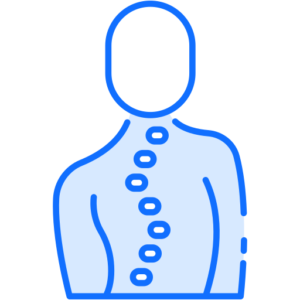SCOLIOSIS TREATMENT

Scoliosis is a medical condition in which the spine, or backbone, has an abnormal curvature. The spine is made up of a series of bones called vertebrae, which are stacked on top of each other to form a vertical column. In a healthy spine, the vertebrae are arranged in a straight line, but in a spine with scoliosis, the vertebrae are twisted or curved, resulting in an “S” or “C” shape. Scoliosis can occur in any part of the spine, but it most commonly occurs in the thoracic (mid-back) and lumbar (lower back) regions.
Scoliosis can be classified into two main types: structural and non-structural. Structural scoliosis is caused by a problem within the bones of the spine, such as a congenital (present at birth) defect or a developmental abnormality. Non-structural scoliosis, on the other hand, is caused by a problem outside of the bones of the spine, such as a muscle spasm or a leg-length discrepancy.
Symptoms of Scoliosis
Symptoms of scoliosis can vary depending on the severity of the curve and the location of the curve within the spine. Some people with scoliosis may not have any noticeable symptoms, while others may experience pain, fatigue, and difficulty breathing. Some common symptoms of scoliosis include:
- Uneven shoulders: One shoulder may appear higher or more prominent than the other.
- Raised hip or shoulder blade: The shoulder blade on the concave side of the curve may appear raised, while the hip on the convex side of the curve may appear raised.
- Visible curve in the spine: The curve may be visible when the person is standing or bending forward.
- Uneven waist or rib cage: The waist or rib cage may appear asymmetrical.
- Back pain: Some people with scoliosis may experience back pain, although it is not a common symptom.
Diagnosis of Scoliosis
Scoliosis is typically diagnosed through a physical examination, during which the doctor will look for any signs of a curved spine, as well as an x-ray. The x-ray will be used to determine the degree of the curve and to track the progression of the condition over time. The degree of the curve is measured using the Cobb angle, which is the angle between the most tilted vertebrae in the curve. A curve of 10 degrees or less is considered mild, a curve of 25-40 degrees is considered moderate, and a curve of more than 40 degrees is considered severe.
What Methods Are Used for Treating Scoliosis?
Treatment for scoliosis depends on the severity of the curve, the location of the curve within the spine, and the patient’s age. For mild cases, treatment may not be necessary, but the patient will be monitored regularly to ensure the condition does not worsen. For moderate to severe cases, treatment may include the use of a brace, physical therapy, and in some cases, surgery.
Non-surgical Methods:
Bracing is often the first line of treatment for children and adolescents with scoliosis, as it can help to slow or stop the progression of the curve. The most commonly used brace is the Boston brace, which is worn around the chest and abdomen. The brace is worn for as many hours per day as possible, typically 22-23 hours, and it is worn until the child reaches skeletal maturity.
Physical therapy can help to improve muscle strength and flexibility, which can help to reduce pain and improve posture. The therapist will work with the patient to develop a personalized exercise program, which may include exercises to improve core strength and stability, as well as exercises to improve flexibility and range of motion.
Surgery:
Surgery is typically only recommended for patients with severe scoliosis who have not had success with bracing or physical therapy. The most common surgical procedure used to treat scoliosis is spinal fusion, which involves joining two or more vertebrae together to create a solid bone. This helps to straighten the spine and prevent further progression of the curve. The surgery may be done using traditional open surgery or using a minimally invasive technique.
In conclusion, scoliosis is a medical condition that affects the spine and causes an abnormal curvature. It can be classified into two main types: structural and non-structural. Symptoms can vary depending on the severity of the curve and the location of the curve within the spine. The condition is typically diagnosed through a physical examination and x-ray. Treatment for scoliosis depends on the severity of the curve, the location of the curve within the spine, and the patient’s age, and can include bracing, physical therapy and in severe cases, surgery.
Why Choose Us?
At Dr Özgür Akşan – Health Türkiye, we have been providing top-quality neurosurgical treatment options for almost a decade under the guidance and leadership of Op. Dr. Özgür Akşan. Our team is comprised of highly experienced and skilled surgeons, including Dr. Özgür Akşan, Dr. Nail Özdemir, and Dr. Feryal Akşan, all of them having more than 20 years of experience in medicine.
We offer a wide range of treatment options for various neurosurgical conditions, including herniated discs, lumbar spinal stenosis, traumatic brain injury, brain tumors, cervical disc herniation, Chiari malformation, carpal tunnel syndrome, and more. Our team is highly skilled in performing advanced neurosurgical procedures, such as microsurgical discectomy, endoscopic discectomy, spinal fusion instrumentation, craniotomy, craniectomy, gamma-knife radiation therapy, and many more.
At Dr Özgür Akşan – Health Türkiye, we are committed to providing personalized care and tailored treatment plans for each patient based on their unique needs and medical history. Our clinic in Izmir is equipped with the latest technology and we are working with private hospitals with state-of-the-art facilities to ensure the highest level of care for our patients.
Choose Dr Özgür Akşan – Health Türkiye for your neurosurgical needs and experience the expertise and care of our highly trained team of neurosurgeons, led by Dr. Özgür Akşan himself.
